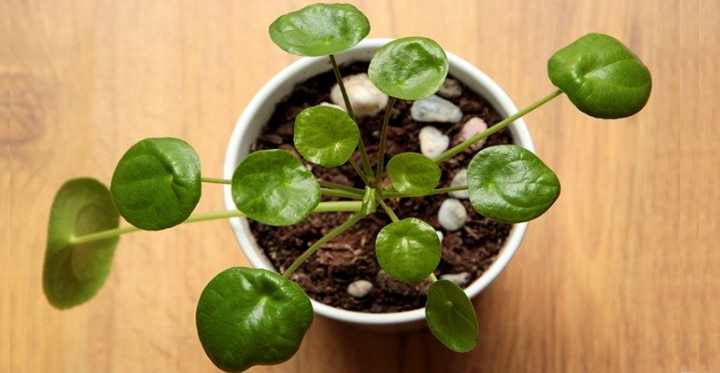The householdplant Chinese money plant (Pilea peperomioides) is very simple to look after. These plants may be used to decorate any interior with their pancake-shaped emerald green leaves and exquisite stems. This lucky blooming plant is rumored to bring wealth and luck to its owners, and it is also known as the UFO plant, missionary plant, and pancake plant.
How to care for a Chinese money plant: When cultivated in bright indirect sunlight, well-draining potting soil, and high humidity, the Pilea peperomioides thrives. Water when the top 1″ (2.5 cm) of soil is dry and fertilize monthly throughout the growing season to maintain an indoor temperature between 60°F and 75°F (15° – 23°C).
Pilea peperomioides is a Chinese native that thrives in damp woods. This plant belongs to the Urticaceae family and genus Pilea and has flat round coin-like leaves. It can tolerate temperatures as low as 50°F (10°C) when it’s growing out in the open. This is a popular houseplant, but it’s uncommon in the wild. The Chinese money plant is ideal for closed terrariums because of its high humidity and warmth requirements.
The glossy large circle leaves and slender, fragile stems of these “pancake plants” are a striking characteristic. The spherical leaves may grow up to 4″ (10 cm) in diameter, while the lengthy stems may reach up to 12″ (30 cm). When placed in a bright indoor environment and given proper care, Chinese money plants grow quickly.
The UFO plant might produce clusters of tiny white flowers on pink stems if you’re lucky enough. You’ll learn how to care for this low-maintenance indoor plant in this article. You may learn some care guidelines for your Pilea plant at the conclusion of the article.
How to Care for Chinese Money Plant (Pilea peperomioides)
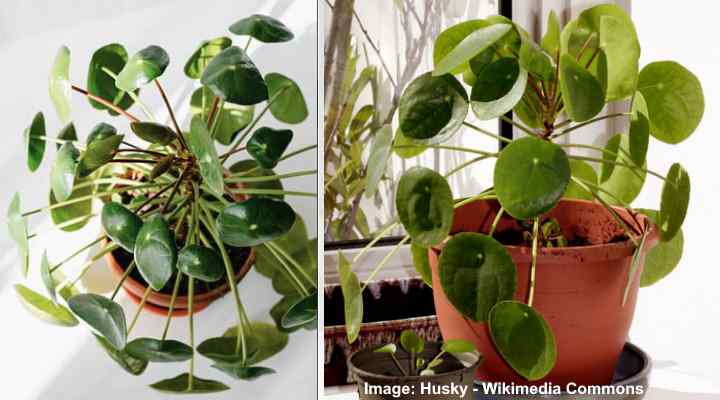
The flat circle leaves of the Pilea peperomioides plant, also known as the “Chinese money plant,” originated in China. When growing these plants at home, however, there are a few points to consider. For Chinese money plants, the following three essential care requirements must be met:
- Light that is adequate, but not exposed to direct sunlight.
- Moisture that isn’t too wet or soggy is ideal.
- At least 50% relative humidity is required.
Chinese Money Plant Light Requirements
To flourish, Chinese money plants require a lot of bright indirect light. Place it in an east-facing windowsill, where it receives just enough morning light. To avoid Scorching the Leaves, keep the Pilea out of direct sunlight. These plants develop lengthy, leggy stems and lose their appealing look when they grow in low-light situations.
The fastest growth is achieved by growing a Chinese money plant in full sun. You may put your potted Pilea peperomioides plant on a balcony, patio, or deck throughout the summer. It is, however, important to keep it in a shady spot and out of the sun’s rays.
Brown spots on the leaves are one of the signs that your pancake plant is receiving too much sun. To improve the plant’s aesthetics, you’ll have to trim these off. Also, move the pot to a shady spot where it will not be exposed to direct sunlight. Low-light Chinese money plants will grow slower than high-light plants.
Long stems and sparse foliage characterize this slow growth. A bushy growth pattern may be encouraged by pruning. Move the plant to a brighter spot if feasible.
The Best Soil for Chinese Money Plant
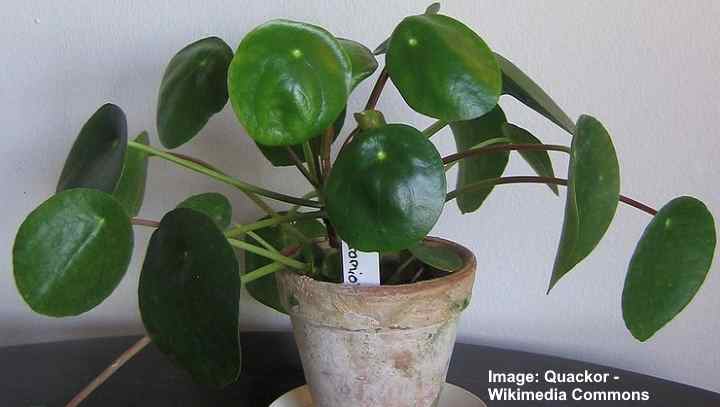
To avoid root rot, grow your pilea plant in a potting mix with excellent drainage. Excess moisture in the soil is kept away from roots by well-draining soil. A combination of potting soil, peat moss, and perlite is recommended for growing Pilea peperomioides.
Between waterings, a well-draining potting medium should be mostly dry. Roots will be constantly wet if the soil is too compact, putting your plant at risk of root rot or fungal diseases. Nevertheless, for successful development, the potting medium must retain some moisture.
Mix equal proportions of light houseplant soil, peat moss, and perlite to make the ideal potting blend for your Chinese money plant. Air will flow more freely and water will drain quicker in this kind of medium. Repot your plant with a light potting mix if you notice that water tends to collect on the soil surface or drains slowly.
How to Water Pilea peperomioides (Pancake Plant)

After the top soil dries out, thoroughly water your Chinese money plant and allow all of the water to escape. Only when the top 1 to 2 inches (2.5 to 5 cm) of soil is completely dry should you water the plant. By watering the earth till it drains out at the bottom, you can thoroughly water the plant. Only water a Pilea plant when the soil is completely dry.
Instead of adhering to a rigid watering schedule, rely on the dryness of the soil. To check for dryness, firmly press the soil. Wait until the soil has dried before watering if there is any moisture. In the summer, you should water your money plant more often than in the winter.
Always thoroughly water the soil when watering a pancake plant or any other houseplant. Roots need to be properly hydrated in order to stay healthy, so deep watering is required. Let all of the water drain out after each soaking. As a result, it’s a good idea to make sure there isn’t too much water in the saucer beneath the pot.
Proper watering of houseplants also means not watering excessively or shallowly. A damp environment is created on the soil surface when this type of watering is used. Fungus gnats or white plant soil mold are common problems for your graceful houseplant when it is watered frequently and shallowly. Also, your plant may be subjected to under-watering if the roots do not receive enough moisture.
When it comes to watering, it’s always best to err on the side of caution. Rather than watering excessively, Chinese money plants can endure a little drought.
Chinese Money Plant Care: The Right Temperature
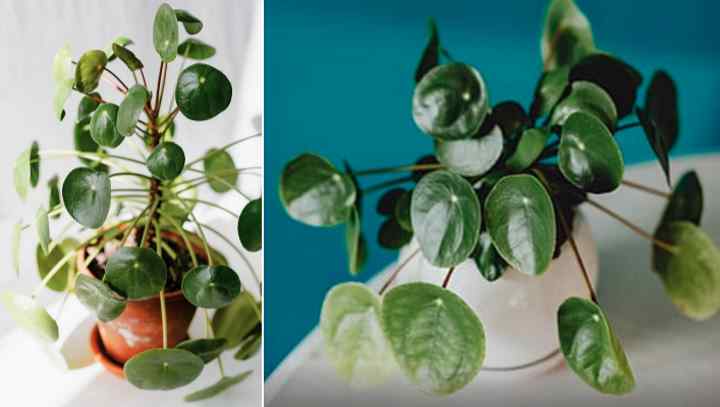
Pilea peperomioides plants prefer temperatures of 60°F to 75°F (15° – 23°C) in ordinary room conditions. In typical room temperatures, growing Chinese money plants is the most effective way to increase their height. Avoid sudden temperature changes and aim to maintain an even room temperature. This is the most important care tip.
Summers or winters are the toughest times to care for your pancake plant. The intense heat of the sun may quickly kill your fragile plant. If Chinese money plants are too close to a radiator in the winter, they may droop. Indoor heating, on the other hand, dries out the air. As a result, for plants to thrive, getting the humidity levels correct is critical.
Outside in temperate climates, potted Chinese money plants may be grown. These lovely plants thrive in warm, humid air and mild temperatures. Pilea peperomioides requires a minimum of 50°F (10°C) for growth. As nighttime temperatures drop, bring the containers inside.
Getting Humidity Right for Pancake Plant (Pilea peperomioides)
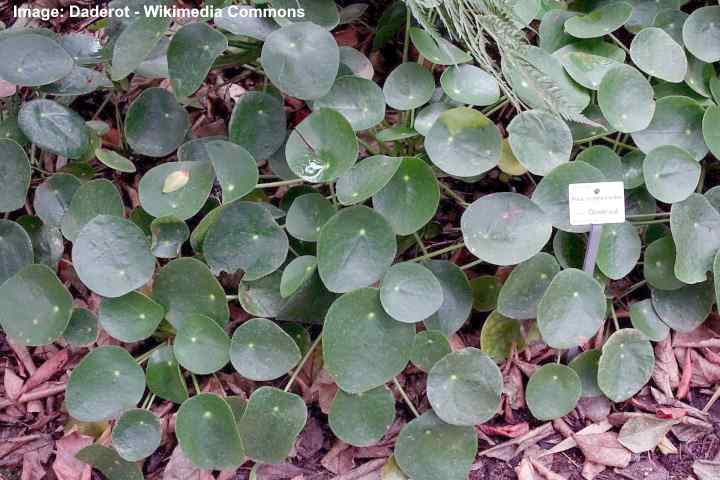
Healthy Chinese money plant growth requires Pilea peperomioides to thrive in high humidity. In comparison to the tropical native habitat of the plant, indoor household air is drier. To grow properly, your Pilea plant must have at least 50% humidity. Misting your plant, a pebble tray, or a room humidifier are all options for keeping humidity levels in check.
To keep the air humid enough for your tropical houseplants, follow these top care tips:
- Mist the leaves—To increase humidity for your plant, mist the leaves with a fine spray. Every other day, fill a spray bottle with clean water and spray the plant.
- Place on a pebble tray—Put a layer of little stones in a tray to make a humidifying tray. Fill the tray halfway up with water. To naturally humidify the plant, put it on the pebbles with Chinese money.
- Use a room humidifier—A humidifier is a terrific option if you have a lot of tropical houseplants. For Pilea peperomioides to thrive, the unit will maintain a proper level of humidity in the room.
Wiping the leaves with a moist cloth is another way to care for your Chinese money plant. This method of cleaning money plant leaves gets rid of a lot of moisture. You also help the plants photosynthesize more effectively by removing dust from the brilliant circular leaves.
During the winter, you’ll have to modify your watering and humidification schedule. Air becomes too dry when heating is allowed. Plants also grow more slowly and need less water. As a result, water less frequently in the winter and make sure that humidity is high.
How to Fertilize Chinese Money Plant for Healthy Growth

In the spring and summer, feed your pilea plant with a diluted houseplant fertilizer every month to ensure that it receives enough nutrients. Regular fertilizer helps your plant stay healthy by increasing growth, keeping the leaves green and lush, and maintaining vitality. Pancake plants benefit most from all-purpose fertilizer. Only remember to feed the plant throughout the spring and summer growing seasons. There isn’t a lot of feeding required for Chinese money plants. A 20-20-20 fertilizer solution should normally be sufficient if diluted by half.
It’s helpful to be aware that mineral salts may build up in the potting soil. These salts may damage a plant’s development by burning roots. Flush the soil on a regular basis, therefore. Gently run water over the soil for two to three minutes to eliminate excess minerals. Put the plant back in a bright location and allow all of the water to drain.
Pilea peperomioides grows slower in the winter, as do other houseplants. Therefore, refrain from fertilizing your plant from autumn through early spring. When the earth is dry, just a little watering is required, but regular misting is required to increase humidity.
Pruning Chinese Money Plant
Pruning can help Chinese money plants have a bushy look. Trim off the upper stems of your Pilea plants if they grow excessively long. Pinch off young shoots after a bud to encourage bushy growth. Dead or decaying leaves and stems should also be removed.
Propagating Chinese Money Plant

Planting the little plantlets produced from the mother plant is one of the simplest ways to propagate Chinese money plants. From the roots of the mother plant, small plantlets develop. These can be grown separately to create new Pilea plants. You may have more of these lovely houseplants in your room very soon.
How to propagate a Chinese money plant:
- Small plantlets growing from the ground may be visible.
- For about 1″ (2.5 cm) down the stem, follow it under the soil.
- Peel the infant plant away with a clean, sharp knife.
- Wait for a few weeks for the roots of the small plant to appear in a jar of water.
- Fill the small pot with the proper potting material.
Repotting Chinese Money Plant
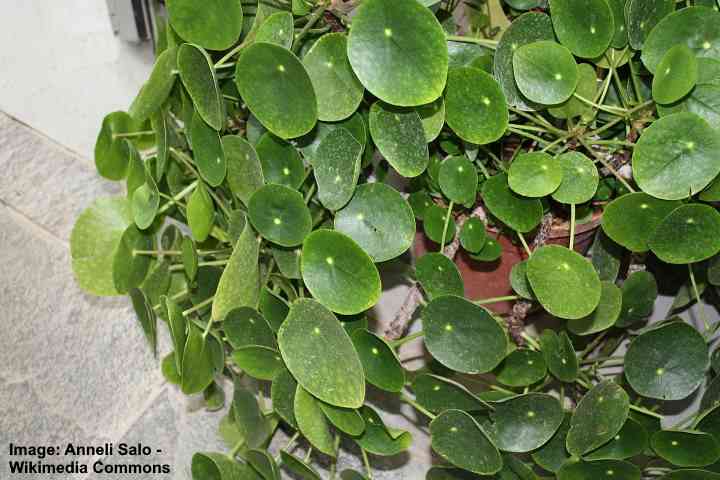
To avoid the plant from becoming rootbound, repot a Chinese money plant every now and then in the spring. You can refresh the potting soil and check for signs of root damage when repotting a Pilea. Select a planter that is 1″ to 2″ (2.5 to 5 cm) bigger than the current one to repot a pancake plant.
How can you tell if it’s time to repot a Chinese money plant? Here are a few indicators:
- The drainage holes have roots protruding from them.
- Since the container is being filled with roots, water drains at a steady rate.
- Since the roots cannot be nourished, the plant begins to grow slower than usual.
How to repot a Chinese money plant:
- Remove the container from the plant and root ball gently.
- Untangle the roots by removing any excess soil.
- Damage to the roots, such as brown or mushy roots, should be inspected. Trim to your liking.
- Fill a new, bigger pot with the correct Pilea potting soil halfway.
- Fill the empty space with potting soil and put the money plant in the new pot.
- Plant it in a sunny spot and thoroughly water it before setting it out in the open.
Caring for Chinese Money Plant: Pests

Eradicating a pest infestation on your pilea plant is extremely important, as they are resistant to them. Aphids and thrips, for example, are tiny insects that can infect your plant. It is crucial to take swift action if you notice signs of any houseplant pests. These persistent “bugs” can quickly damage a plant and spread to other houseplants.
Drooping stems, yellow leaves, or curling leaves are all indications that your attractive plant has a pest problem. If you look up close beneath the leaves, you may even see the tiny creatures. Spider mites, gnats, aphids, mealybugs, scale, and thrips are all susceptible to natural household remedies. Please read my article on how to get rid of houseplants insects for the greatest guidance.
Proper Chinese Money Plant Care: Diseases
Most tropical houseplants are resistant to illness, including the Chinese money plant. When caring for Pilea plants, root rot is the most common problem. If you water your plants properly, this plant disease can be avoided. Always water your plant when the soil is partially dry to prevent fungal or bacterial diseases.
It could be due to diseased roots if your Chinese money plant appears to be dying. Repot your dying Pilea with fresh, sterile potting soil to try and revive it. Don’t water the plant until it’s completely dry above the 2″ (5 cm) mark.
FAQ About Chinese Money Plant (Pilea peperomioides)

Is Chinese money plant poisonous?
Cats and dogs are unlikely to be poisoned by a Pilea peperomioides. The Urticaceae family of plants is listed by the American Society for the Prevention of Cruelty to Animals (ASPCA) as a non-toxic plant for cats.
Does the Chinese money plant clean the air?
Air purification in a room or workplace may be aided by using Chinese money plants. Air quality in rooms populated with multiple plants has been shown to be superior to air quality in rooms devoid of them. Moreover, plants offer a more tranquil, serene atmosphere to any room.
How can I make my money plant grow faster?
To speed up growth, place your money plant in a well-lit area that is shielded from direct sunlight. Watering when the soil is partly dry, maintaining a high humidity level, and feeding monthly all help to promote excellent growth.
Why is my Chinese money plant dying?
Something isn’t right if there are brown leaves, yellow leaves, or a drooping Chinese money plant. Check the soil for waterlogging before moving on to step 2. Also, if your plant appears to be on the verge of dying, inspect for signs of pests.
